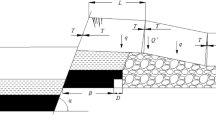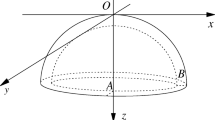Abstract
Mining activity near faults easily induces rock bursts, and reasonable reservation of coal pillars can effectively prevent this disaster. Therefore, this paper establishes an engineering-scale fast Lagrangian analysis of continua in 3 dimensions (FLAC3D) numerical model and rheological physical model of rock burst induction, studies the mining influence on the strata behaviors of fault band and elastic rock systems (abutment stress, fault plane stress, roof settlement, and fault slipping and its speed), and analyzes the effect of different remaining fault coal pillars on rock burst induction. The results show that in a large remaining coal pillar (LRFCP), mining activity has little influence on faults, while strata movement causes high-stress concentrations and a large accumulation of strain energy in the coal pillar, which easily induces a strain burst. Meanwhile, in a small remaining fault coal pillar (SRFCP), mining significantly affects the fault mechanical environment and its movement. The strata behaviors are coordinated variations of deformation and fault plane stress under the coupling of the mining effect and fault effect, which easily cause fault-slip bursts, and the fault effect is more prominent. Finally, the above results are verified by two cases regarding microseisms and shock bumps. The study results can provide theoretical significance and have guiding value for the face layout, fault coal pillar remainder, and evaluation and prevention of rock bursts.
















Similar content being viewed by others
Change history
22 March 2022
A Correction to this paper has been published: https://doi.org/10.1007/s10064-022-02654-7
References
Bian K, Liu J, Zhang W, Zheng XQ, Ni SH, Liu ZP (2019) Mechanical behavior and damage constitutive model of rock subjected to water-weakening effect and uniaxial loading. Rock Mech Rock Eng 52(1):97–106
Chen XH, Li WQ, Yan XY (2012) Analysis on rock burst danger when fully-mechanized caving coal face passed fault with deep mining. Saf Sci 50(4):645–648
Dieterich JH (1979) Modeling of rock friction, I: experimental results and constitutive equations. J Geophys Res 84(B5):2161–2168
Fan QZ (2007) Experimental study on creep and its disturbed effect of rocks. Chin J Rock Mech Eng 26(1):216
Feng F, Li XB, Rostami J, Peng DX, Li DY, Du K (2019) Numerical investigation of hard rock strength and fracturing under polyaxial compression based on Mogi-Coulomb failure criterion. Int J Geomech 19(4):04019005
Hu SC, Tan YL, Ning JG, Guo WY, Liu XS (2017) Multiparameter monitoring and prevention of fault-slip rock burst. Shock Vib 2017:1–8
Jiang LS, Wang P, Zhang PP, Zheng PP, Xu B (2017a) Numerical analysis of the effects induced by normal faults and dip angles on rock bursts. Compte Rendu Mecanique 345(10):690–705
Jiang LS, Zhang PP, Chen LJ, Hao Z, Sainoki A, Mitri HS, Wang QB (2017b) Numerical approach for goaf-side entry layout and yield pillar design in fractured ground conditions. Rock Mech Rock Eng 50(11):3049–3071
Jiang JQ, Wang P, Jiang LS, Zheng PQ, Feng F (2018) Numerical simulation on mining effect influenced by a normal fault and its induced effect on rock burst. Geomechanics and Engineering 14(4):337–344
Jiang JQ, Wu QL, Qu H (2015) Characteristic of mining stress evolution and activation of the reverse fault below the hard-thick strata. J China Coal Soc 40(2):267–277
Jiang LS, Wang P, Zheng PQ, Luan HJ, Zhang C (2019) Influence of different advancing directions on mining effect caused by a fault. Adv Civ Eng 7306850
Li XL, Chen SJ, Wang EY, Li Zh (2021) Rockburst mechanism in coal rock with structural surface and the microseismic (MS) and electromagnetic radiation (EMR) response. Eng Fail Anal 124:105396
Lin YD, Tu M, Liu WZ, Wu JQ (2012) Faults activation mechanism based on gradient-dependent plasticity. J China Coal Soc 37(12):2060–2064
Li Z, Zhou H, Hu DW, Zhang CQ (2020) Yield criterion for rocklike geomaterials based on strain energy and CMP model. Int J Geomech 20(3):04020013
Li ZH, Dou LM, Lu CP, Mou ZL, Cao AY (2008) Study on fault induced rock bursts. Int J Min Sci Technol 18(3):321–326
Li ZH (2009) Research on rockburst mechanism induced by fault slip during coal mining operation. Dissertation, China University of Mining and Technology, Beijing, China
Luo Y, Gong FQ, Li XB, Wang SY (2020) Experimental simulation investigation of influence of depth on spalling characteristics in circular hard rock tunnel. J Cent South Univ 27:891–910
Lv JG, Jiang YD, Li SG, Ren SD, Jiang WZ, Zhang ZC (2014) Characteristic and mechanism research of coal bumps induced by faults based on extra thick and hard roof. J China Coal Soc 39(10):1961–1969
Pan YS (1999) Study on rockburst initiation and failure propagation. Dissertation, Tsinghua University, Beijing, China
Ren Z, Zhang KX, Jiang YD (2021) Research on response of stress field in working face during thrust fault activation process under mining disturbance. Coal Science and Technology 49(9):61–68
Sainoki A, Mitri HS (2014a) Dynamic behaviour of mining induced fault slip. J rock Mech Min Sci Geomech Abstr 66:19–29
Sainoki A, Mitri HS (2014b) Evaluation of fault-slip potential due to shearing of fault asperities. Can Geotech J 52(10):1417–1425
Shen MR, Chen JF (2006) Rock mechanics. Tongji University Press, Shanghai
Sun Q, Hu XH (2008) On the strain-softening of geotechnical constitutive model and Weibull distribution. Metal Mine 388(10):39–42
Wang H, Zhao YX, Mu ZL, Jiao ZH, Zhang X, Lu ZG (2017) Characteristics of seismic activity and tensile-slip features of fault under stress and displacement disturbance in full-mechanized work face. J China Coal Soc 42(10):2573–2581
Wang P, Jiang LS, Li XY, Qin GP, Wang EY (2018a) Physical simulation of mining effect caused by a fault tectonic. Arab J Geosci 11(23):741. https://doi.org/10.1007/s12517-018-4088-z
Wang P, Jiang LS, Jiang JQ, Zheng PQ, Li W (2018b) Strata behaviors and rock burst–inducing mechanism under the coupling effect of a hard, thick stratum and a normal fault. Int J Geomech 18(2):04017135
Wang P, Jiang LS, Zheng PQ, Qin GP, Zhang C (2019) Inducing mode analysis of rock burst in fault-affected zone with a hard-thick stratum occurrence. Environ Earth Sci 78:467
Wang P, Jia HJ, Zheng PQ (2020) Sensitivity analysis of bursting liability for different coal-rock combinations based on their inhomogeneous characteristics. Geomat Nat Haz Risk 11(1):149–159
Wang P (2018) Study on mining effect caused by normal fault and the inducing mechanism of rock burst. Dissertation, Shandong University of Science and Technology, Qingdao, China
Wang P, Zhou HY, Wan GX, Zheng PQ (2021a) Stress characteristics of different mining directions adjacented fault under hard thick roof. J Min Strat Cont Eng 3(4):043529
Wang T (2012) Mechanism of coal bumps induced by fault reactivation. Dissertation, China University of Mining and Technology, Beijing, China
Wang XB, Ma B, Lv JQ (2014) Numerical simulation of failures, precursors and stick-slip processes for typical fault structures at a laboratory scale. Seismology and Geology 36(3):845–861
Wang XB, Ma J, Pan YS (2013) Numerical simulation of stick-slip behaviours of typical faults in biaxial compression based on a frictional-hardening and frictional-softening model. Geophys J Int 194(2):1023–1041
Wang XB, Liu XT, Cen ZH, Xue CY (2021b) Study on evolution of the fault slip during the normal fault footwall mining based on a continuum-discontinuum method. J Disaster Prev Mit Eng 41(4):804–812
Wang XQ, Gao FQ, Li JZ, Yuan GY, Yang L (2021c) Realization method and influencing factors of excavation-induced slip for locked fault. Journal of China Coal Society. https://doi.org/10.13225/j.cnki.jccs.2021c.0950
Wu H, Ma D, Spearing AJS, Zhao GY (2021) Fracture response and mechanisms of brittle rock with different numbers of openings under uniaxial loading. Geomechanics and Engineering 25(6):481–493
Xia YX, Wang JH, Mao DB (2016) Analysis of fault activation induced rock burst risk based on in-situ stress measurements. J China Coal Soc 41(12):3008–3015
Zhang LM (2001) Rock adhesive slide and the application of its mathematic model. Guangdong Water Resources and Hydropower 12(6):8–11
Zhang LM, Zhenyu T (1992) A visco-elastoplastic model for fault rocks and its application to earthquake research. Acta Seismol Sin 5(4):667–674
Zhu ST, Jiang FX, Kouame KJA, Li XF, Tan WF, Zhang B, Zhang H (2016) Fault activation of fully mechanized caving face in extra-thick coal seam of deep shaft. Chin J Rock Mech Eng 35(1):50–58
Funding
The study was funded by the National Natural Science Foundation of China (No. 52104092) and the Shandong Provincial Natural Science Foundation (No. ZR2020QE120).
Author information
Authors and Affiliations
Corresponding author
Ethics declarations
Conflict of interest
The authors declare no competing interests.
Additional information
The original online version of this article was revised: This article has an error. In the PDF version, figure 13 has a discrepancy with the xml version. Thus, resulted to a corrupt version of the PDF.
Rights and permissions
About this article
Cite this article
Wang, P., Luan, H. Size effect analysis of remaining coal pillar on rock burst caused by fault. Bull Eng Geol Environ 81, 108 (2022). https://doi.org/10.1007/s10064-022-02611-4
Received:
Accepted:
Published:
DOI: https://doi.org/10.1007/s10064-022-02611-4




